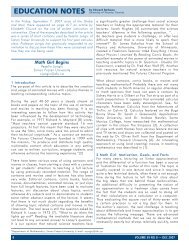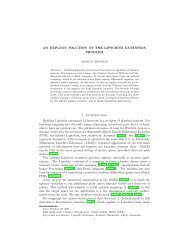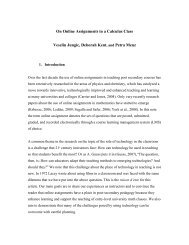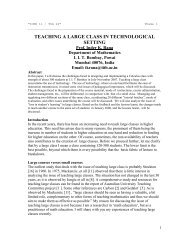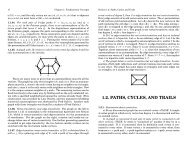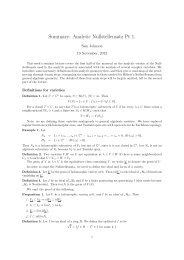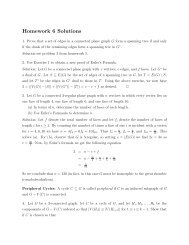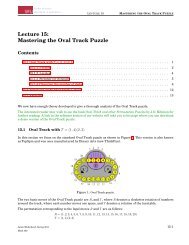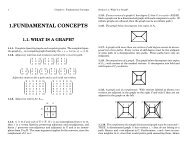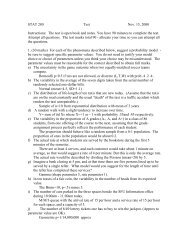Lecture 4: Permutations: Cycle Notation - People.stat.sfu.ca
Lecture 4: Permutations: Cycle Notation - People.stat.sfu.ca
Lecture 4: Permutations: Cycle Notation - People.stat.sfu.ca
Create successful ePaper yourself
Turn your PDF publications into a flip-book with our unique Google optimized e-Paper software.
Week Date Sections<br />
from FS2009<br />
Part/ References Topic/Sections Notes/Speaker<br />
1 Sept 7 I.1, I.2, I.3 Combinatorial Symbolic methods<br />
2 14 I.4, I.5, I.6<br />
Structures<br />
FS: Part A.1, A.2<br />
Unlabelled structures<br />
3 21 II.1, II.2, II.3<br />
Comtet74<br />
Handout #1<br />
Labelled structures I<br />
4 28 II.4, II.5, II.6<br />
(self study)<br />
Labelled structures II<br />
5 Oct 5 III.1, III.2<br />
Combinatorial<br />
parameters<br />
FS A.III<br />
(self-study)<br />
Combinatorial<br />
Parameters<br />
6 12 IV.1, IV.2 Multivariable GFs<br />
Asst #1 Due<br />
7 19 IV.3, IV.4 Analytic Methods Complex Analysis<br />
8<br />
9<br />
26<br />
Nov 2<br />
IV.5 V.1<br />
FS: Part B: IV, V, VI<br />
Appendix B4<br />
Stanley 99: Ch. 6<br />
Handout #1<br />
Singularity Analysis<br />
Asymptotic methods<br />
Asst #2 Due<br />
10<br />
9 VI.1<br />
(self-study)<br />
Sophie<br />
12 A.3/ C<br />
Introduction to Prob. Mariolys<br />
11<br />
12<br />
f aculty of science MATH 895-4 Fall 2010<br />
department of mathematics Course Schedule<br />
LECTURE 4 PERMUTATIONS: CYCLE NOTATION<br />
<strong>Lecture</strong> 4:<br />
<strong>Permutations</strong>: <strong>Cycle</strong> <strong>Notation</strong><br />
Contents<br />
4.1 <strong>Permutations</strong>: <strong>Cycle</strong> <strong>Notation</strong> . . . . . . . . . . . . . . . . . . . . . . . . . . . . . . . . . . 1<br />
4.2 Products of <strong>Permutations</strong>: Revisited . . . . . . . . . . . . . . . . . . . . . . . . . . . . . . 4<br />
4.3 Properties of <strong>Cycle</strong> Form . . . . . . . . . . . . . . . . . . . . . . . . . . . . . . . . . . . . . 5<br />
4.4 Order of a Permutation: Revisited . . . . . . . . . . . . . . . . . . . . . . . . . . . . . . . 6<br />
18 IX.1 Limit Laws and Comb Marni<br />
4.5 Inverse of a Permutation: Revisited . . . . . . . . . . . . . . . . . . . . . . . . . . . . . . 7<br />
20 IX.2 Random Structures<br />
and Limit Laws<br />
Discrete Limit Laws Sophie<br />
23 IX.3<br />
FS: Part C<br />
(rotating<br />
presentations)<br />
Combinatorial<br />
instances of discrete<br />
Mariolys<br />
25 IX.4 Continuous Limit Laws Marni<br />
4.6 Summary of <strong>Permutations</strong> . . . . . . . . . . . . . . . . . . . . . . . . . . . . . . . . . . . . 8<br />
4.7 Working with <strong>Permutations</strong> in SAGE . . . . . . . . . . . . . . . . . . . . . . . . . . . . . . 9<br />
Quasi-Powers and<br />
134.830 Exercises IX.5 . . . . . . . . . . Sophie<br />
Gaussian . . . limit . . laws . . . . . . . . . . . . . . . . . . . . . . . . . . . . . . . 10<br />
14 Dec 10 Presentations Asst #3 Due<br />
In this section we introduce a simple, yet extremely powerful, notation for permutations: cycle form<br />
We’ll revisit the concepts of products (composition), order, and inverses, and see how our new notation<br />
simplifies <strong>ca</strong>lculations.<br />
This lecture corresponds to Section 3.3 of Joyner’s text.<br />
4.1 <strong>Permutations</strong>: <strong>Cycle</strong> <strong>Notation</strong><br />
Dr. Marni MISHNA, Department of Mathematics, SIMON FRASER UNIVERSITY<br />
Version of: 11-Dec-09<br />
Consider the 5-cycle permutation α defined as follows:<br />
α(1) = 2, α(2) = 3, α(3) = 4, α(4) = 5, α(5) = 1.<br />
The array form of α is shown in Figure 1a, and the arrow diagram is shown in Figure 1b.<br />
Another arrow diagram which provides a more visual display of the structure of the permutation is<br />
shown in Figure 1c. This is <strong>ca</strong>lled the cycle-arrow form.<br />
In this diagram all the information for α is still present. What is α(3)? To determine this, look at the<br />
diagram and find 3, then see where the arrow takes it. In this <strong>ca</strong>se it takes it to 4, so α(3) = 4.<br />
There are a couple of nice things about cycle arrow form: (1) it displays more visually the cycle<br />
structure (i.e. we <strong>ca</strong>n see the 5 numbers cycling around the circle, which is why we <strong>ca</strong>lled it a 5cycle),<br />
and (2) it uses only one set of numbered dots, making the diagram more compact than our<br />
original arrow form.<br />
Jamie Mulholland, Spring 2010<br />
Math 302<br />
1
Week Date Sections<br />
from FS2009<br />
Part/ References Topic/Sections Notes/Speaker<br />
1 Sept 7 I.1, I.2, I.3 Combinatorial Symbolic methods<br />
2 14 I.4, I.5, I.6<br />
Structures<br />
FS: Part A.1, A.2<br />
Unlabelled structures<br />
3 21 II.1, II.2, II.3<br />
Comtet74<br />
Handout #1<br />
Labelled structures I<br />
4 28 II.4, II.5, II.6<br />
(self study)<br />
Labelled structures II<br />
5 Oct 5 <br />
1<br />
III.1, III.2<br />
2 3 4<br />
Combinatorial<br />
parameters <br />
FS 5A.III<br />
Combinatorial<br />
Parameters<br />
6 12 IV.1, IV.2 (self-study)<br />
Multivariable GFs<br />
α =<br />
Asst #1 Due<br />
7<br />
8<br />
9<br />
19 IV.3, IV.4<br />
(a) array form<br />
26<br />
IV.5 V.1<br />
Nov 2<br />
Analytic Methods<br />
FS: Part B: IV, V, VI<br />
Appendix B4<br />
Stanley 99: Ch. 6<br />
Handout #1<br />
Complex Analysis<br />
Singularity Analysis<br />
Asymptotic methods<br />
Asst #2 Due<br />
9 VI.1<br />
(self-study)<br />
Sophie<br />
10<br />
12 A.3/ C<br />
Introduction to Prob. Mariolys<br />
11<br />
12<br />
20 IX.2 Random Structures<br />
and Limit Laws<br />
Discrete Limit Laws Sophie<br />
23 IX.3<br />
FS: Part C<br />
(rotating<br />
presentations)<br />
Combinatorial<br />
instances of discrete<br />
Mariolys<br />
25 IX.4 Continuous Limit Laws Marni<br />
13 30 IX.5<br />
f aculty of science MATH 895-4 Fall 2010<br />
department of mathematics Course Schedule<br />
LECTURE 4 PERMUTATIONS: CYCLE NOTATION<br />
2 3 4 5 1<br />
(b) arrow form (c) cycle-arrow form<br />
Figure 1: Different representations for a 5-cycle.<br />
Quasi-Powers and<br />
Gaussian limit laws<br />
Sophie<br />
α = (1, 2, 3, 4, 5)<br />
(d) cycle form<br />
Though mathemati<strong>ca</strong>lly satisfactory, the cycle arrow form is cumbersome to draw. However, leaving<br />
18 IX.1 Limit Laws and Comb Marni<br />
out the arrows we <strong>ca</strong>n simply write the 5-cycle as:<br />
α = (1, 2, 3, 4, 5)<br />
This represents that fact that α maps each number to the next one in the list, and maps 5 back<br />
around to the start of the list, which is 1. This representation is shown in Figure 1d.<br />
All 14 representations Dec 10 in Figure Presentations 1 have their own benefits, Asst #3 Due but it is the cycle notation that is the most<br />
compact, and this will be the notation we primarily use in this course.<br />
When working with cycle notation, α = (1, 2, 3, 4, 5), you should read it as follows:<br />
“1 goes to 2, 2 goes to 3, 3 goes to 4, 4 goes to 5, and 5 goes to 1.”<br />
We don’t need to start at 1 when writing down the cycle form, if we started at 3, for instance, and<br />
constructed the list of numbers we visit by traveling around Figure 1c then we get (3, 4, 5, 1, 2). This is<br />
Dr. Marni MISHNA, Department of Mathematics, SIMON FRASER UNIVERSITY<br />
Version another of: 11-Dec-09 perfectly acceptable representation of α: reading this cycle notation as described above will<br />
tell us exactly how α acts as a function. In particular, we <strong>ca</strong>n represent α by any of the equivalent<br />
cycle forms:<br />
α = (1, 2, 3, 4, 5) = (2, 3, 4, 5, 1) = (3, 4, 5, 1, 2) = (4, 5, 1, 2, 3) = (5, 1, 2, 3, 4).<br />
Despite this notation allowing for non-unique representations of permutations, there is an easy fix.<br />
Just writing the cycle so that the first number is the smallest number in the cycle. In this <strong>ca</strong>se we<br />
would then write α = (1, 2, 3, 4, 5) since 1 is the smallest number in this cycle.<br />
Let’s look at another permutation: β =<br />
Jamie Mulholland, Spring 2010<br />
Math 302<br />
1 2 3 4 5 6 7 8<br />
3 2 7 8 1 4 5 6<br />
<br />
. The cycle arrow form is:<br />
2
Week Date Sections<br />
from FS2009<br />
f aculty of science MATH 895-4 Fall 2010<br />
department of mathematics Course Schedule<br />
LECTURE 4 PERMUTATIONS: CYCLE NOTATION<br />
Part/ References Topic/Sections Notes/Speaker<br />
This reveals so much about the permutation, especially when you imagine taking powers of it: βn .<br />
For instance, 1,3,5,7 only get permuted amongst themselves, so there is no k such that βk (1) = 4.<br />
1 Sept 7 I.1, I.2, I.3 Combinatorial Symbolic methods<br />
Structures<br />
Also, 2 since 14 I.4, a 4-cycle I.5, I.6 has order 4, then Unlabelled β structures<br />
FS: Part A.1, A.2<br />
Comtet74<br />
3 21 II.1, II.2, II.3 Labelled structures I<br />
Handout #1<br />
4 28 II.4, II.5, II.6<br />
(self study)<br />
Labelled structures II<br />
4 would leave 1,3,5,7 untouched: β4 (x) = x when x = 1, 3, 5, 7.<br />
To construct the cycle form of β we we look at the arrow form above and notice that 1 goes to 3, 3 goes<br />
to 7, 7 goes to 5 and 5 goes back to 1. This <strong>ca</strong>n simply be written as (1, 3, 7, 5). Similarly, 2 goes to 2 so<br />
we write this as (2), and the 4, 6, 8 triangle <strong>ca</strong>n be written as (4, 8, 6). This means we <strong>ca</strong>n write β as:<br />
5 Oct 5 III.1, III.2<br />
Combinatorial<br />
parameters<br />
FS A.III<br />
Combinatorial<br />
Parameters<br />
6 12 IV.1, IV.2 (self-study)<br />
Multivariable GFs<br />
Asst #1 Due<br />
7 19 IV.3, IV.4 Analytic Methods Complex Analysis<br />
8<br />
9<br />
26<br />
Nov 2<br />
IV.5 V.1<br />
FS: Part B: IV, V, VI<br />
Appendix B4<br />
Stanley 99: Ch. 6<br />
Handout #1<br />
Singularity Analysis<br />
Asymptotic methods<br />
Asst #2 Due<br />
10<br />
9 VI.1<br />
(self-study)<br />
Sophie<br />
12 A.3/ C<br />
Introduction to Prob. Mariolys<br />
18 IX.1 Limit Laws and Comb Marni<br />
If11 we make one further convention, to leave off any number that gets mapped to itself, then β <strong>ca</strong>n be<br />
20 IX.2 Random Structures<br />
written in a further compact form: Discrete Limit Laws Sophie<br />
and Limit Laws<br />
FS: Part C<br />
Combinatorial<br />
23 IX.3<br />
β = (1, 3, 7, Mariolys 5)(4, 8, 6).<br />
(rotating<br />
12<br />
instances of discrete<br />
presentations)<br />
25 IX.4 Continuous Limit Laws Marni<br />
Quasi-Powers and<br />
An13 expression 30 IX.5 of the form (a1, a2, . . . , am) is <strong>ca</strong>lledSophie an m- cycle.<br />
Gaussian limit laws<br />
14 Dec 10 Presentations Asst #3 Due<br />
Dr. Marni MISHNA, Department of Mathematics, SIMON FRASER UNIVERSITY<br />
Version of: 11-Dec-09<br />
β = (1, 3, 7, 5)(2)(4, 8, 6).<br />
This is a compact way to represent the permutation β, and we haven’t lost any information. For<br />
example, we <strong>ca</strong>n use the cycle form determine β(3) by noticing in (1, 3, 7, 5)(2)(4, 8, 6) the number 3 is<br />
followed by 7, so β(3) = 7. Similarly, β(5) = 1 since from 5 we wrap around in the cycle and get back<br />
to 1.<br />
In this convention, any number not present in the cycle form is assumed to map back to itself.<br />
We say β is the product of a 3-cycle and a 4-cycle.<br />
Example 4.1 To determine the cycle form of the permutation<br />
<br />
1<br />
α =<br />
5<br />
2<br />
1<br />
3<br />
6<br />
4<br />
8<br />
5<br />
4<br />
6<br />
10<br />
7<br />
7<br />
8<br />
2<br />
9<br />
9<br />
<br />
10<br />
3<br />
start with the smallest number in the set, in this <strong>ca</strong>se it is 1. Since α(1) = 5 we begin the cycle by<br />
writing<br />
(1, 5, . . .) . . . .<br />
Next, 5 maps to 4, so we continue building the cycle<br />
(1, 5, 4, . . .) . . . .<br />
Continuing in this way we construct (1, 5, 4, 8, 2, . . .) . . ., and since 2 maps back to 1 then we close off<br />
the cycle:<br />
(1, 5, 4, 8, 2) . . . .<br />
Next, we pick the smallest number that doesn’t appear in any previously constructed cycle. This is the<br />
number 3 in this <strong>ca</strong>se. We now repeat what we just did and construct the cycle involving 3:<br />
(1, 5, 4, 8, 2)(3, 6, 10) . . . .<br />
We now pick the smallest number that doesn’t appear in any previously constructed cycle, which is 7,<br />
and construct the cycle to which it belongs. In this <strong>ca</strong>se 7 just maps to itself:<br />
Jamie Mulholland, Spring 2010<br />
Math 302<br />
(1, 5, 4, 8, 2)(3, 6, 10)(7) . . . .<br />
3
Week Date Sections<br />
from FS2009<br />
Part/ References Topic/Sections Notes/Speaker<br />
1 Sept 7 I.1, I.2, I.3 Combinatorial Symbolic methods<br />
2 14 I.4, I.5, I.6<br />
Structures<br />
FS: Part A.1, A.2<br />
Unlabelled structures<br />
3 21 II.1, II.2, II.3<br />
Comtet74<br />
Handout #1<br />
Labelled structures I<br />
4 28 II.4, II.5, II.6<br />
(self study)<br />
Labelled structures II<br />
Combinatorial Combinatorial<br />
since 5 Oct our 5 convention III.1, III.2 is omit 1-cycles. Therefore, α Asst is the #1 Dueproduct<br />
of a 3-cycle and a 5-cycle.<br />
parameters<br />
Parameters<br />
FS A.III<br />
6 12 IV.1, IV.2 (self-study)<br />
Multivariable GFs<br />
7 19 IV.3, IV.4 Analytic Methods Complex Analysis<br />
8<br />
3<br />
9<br />
26<br />
4 1<br />
Nov 2<br />
IV.5 2 V.1<br />
FS: Part B: IV, V, VI<br />
to cycle Appendix form. B4<br />
Stanley 99: Ch. 6<br />
Handout #1<br />
Singularity Analysis<br />
Asymptotic methods<br />
Asst #2 Due<br />
10<br />
9 VI.1<br />
(self-study)<br />
Sophie<br />
12 A.3/ C<br />
Introduction to Prob. Mariolys<br />
11<br />
12<br />
f aculty of science MATH 895-4 Fall 2010<br />
department of mathematics Course Schedule<br />
LECTURE 4 PERMUTATIONS: CYCLE NOTATION<br />
Finally, the only number remaining is 9 and it maps back to itself so the cycle for of α is<br />
which simplifies to<br />
(1, 5, 4, 8, 2)(3, 6, 10)(7)(9)<br />
α = (1, 5, 4, 8, 2)(3, 6, 10)<br />
Exercise 4.1 Converting<br />
from array to cycle form. Convert the permutation given in array form:<br />
1 2 3 4<br />
Exercise 4.2 Converting from cycle to array form. For the permutation given in cycle form by<br />
(1, 3, 5, 2)(4, 7) ∈ S8, express it in array form.<br />
18 IX.1 Limit Laws and Comb Marni<br />
20 IX.2 Random Structures<br />
and Limit Laws<br />
Discrete Limit Laws Sophie<br />
23 IX.3<br />
FS: Part C<br />
(rotating<br />
presentations)<br />
Combinatorial<br />
instances of discrete<br />
Mariolys<br />
25 IX.4 Continuous Limit Laws Marni<br />
4.2 Products of <strong>Permutations</strong>: Revisited<br />
It is not efficient to convert permutations from cycle form to array from, then compose the permutations<br />
in array form, only to convertQuasi-Powers back toand cycle form. Instead, we will work entirely with the cycle<br />
13 30 IX.5<br />
Sophie<br />
Gaussian limit laws<br />
form but we do so by thinking of their representation in array form.<br />
14 Dec 10 Presentations Asst #3 Due<br />
For example, consider the permutations α = (1, 5, 2, 3) and β = (1, 5, 4)(2, 3) in S5. What is the cycle<br />
for of αβ? Of course, we could just stick the two permutations together, end-to-end, and write<br />
αβ = (1, 5, 2, 3)(1, 5, 4)(2, 3)<br />
but it will be more convenient to express the permutation in disjoint cycle form, that is where the<br />
various cycles have no numbers in common.<br />
We determine the cycle form of αβ by determining exactly how it maps each number, beginning with<br />
Dr. Marni MISHNA, Department of Mathematics, SIMON FRASER UNIVERSITY<br />
Version 1. Keep of: 11-Dec-09 in mind that permutation composition is done from left-to-right, and each cycle that does not<br />
contain a number fixes that number. We have that: (1, 5, 2, 3) sends 1 to 5, (1, 5, 4) sends 5 to 4, and<br />
(2, 3) fixes 4. So the effect of αβ is it sends 1 to 4.<br />
Thus we begin writing the disjoint cycle form as αβ = (1, 4, . . .) . . . .<br />
Repeating this process with 4, we have, cycle-by-cycle, left-to-right,<br />
4 (1,5,2,3)<br />
−−−−−→ 4 (1,5,4)<br />
−−−−→ 1 (2,3)<br />
−−−→ 1,<br />
so that αβ(4) = 1, and the cycle form is now αβ = (1, 4) . . . .<br />
Next we pick the smallest number that is not in any previously constructed cycle, this would be 2.<br />
Repeating this process with 2, cycle-by-cycle, left-to-right,<br />
Jamie Mulholland, Spring 2010<br />
Math 302<br />
2 (1,5,2,3)<br />
−−−−−→ 3 (1,5,4)<br />
−−−−→ 3 (2,3)<br />
−−−→ 2,<br />
4
Week Date Sections<br />
from FS2009<br />
f aculty of science MATH 895-4 Fall 2010<br />
department of mathematics Course Schedule<br />
LECTURE 4 PERMUTATIONS: CYCLE NOTATION<br />
Part/ References Topic/Sections Notes/Speaker<br />
so that αβ(2) = 2, and the cycle for is now αβ = (1, 4)(2) . . . .<br />
1 Sept 7 I.1, I.2, I.3 Combinatorial Symbolic methods<br />
2 14 I.4, I.5, I.6<br />
Structures<br />
FS: Part A.1, A.2<br />
Unlabelled structures<br />
3 21 II.1, II.2, II.3<br />
Comtet74<br />
Handout #1<br />
Labelled structures I<br />
4 28 II.4, II.5, II.6<br />
(self study)<br />
Labelled structures II<br />
Continuing in this way we find that αβ = (1, 4)(2)(3, 5) = (1, 4)(3, 5).<br />
The important thing to keep in mind when multiplying cycles is to keep moving from one cycle to the<br />
next from left-to-right.<br />
5 Oct 5 III.1, III.2<br />
Combinatorial<br />
parameters<br />
FS A.III<br />
Combinatorial<br />
Parameters<br />
6 12 IV.1, IV.2 (self-study)<br />
Multivariable GFs<br />
Asst #1 Due<br />
Example 4.2 Let α = (1, 4, 6, 3, 7)(2, 8) and β = (2, 5, 3)(4, 7, 8, 1) be permutations in S8. Then<br />
αβ = (1, 4, 6, 3, 7)(2, 8)(2, 5, 3)(4, 7, 8, 1) = (1, 7, 4, 6, 2)(3, 8, 5)<br />
7 19 IV.3, IV.4 Analytic Methods Complex Analysis<br />
8<br />
9<br />
26<br />
Nov 2<br />
IV.5 V.1<br />
FS: Part B: IV, V, VI<br />
Appendix B4<br />
Stanley 99: Ch. 6<br />
Handout #1<br />
Singularity Analysis<br />
Asymptotic methods<br />
Asst #2 Due<br />
10<br />
9 VI.1<br />
(self-study)<br />
Sophie<br />
12 A.3/ C<br />
Introduction to Prob. Mariolys<br />
and<br />
βα = (2, 5, 3)(4, 7, 8, 1)(1, 4, 6, 3, 7)(2, 8) = (1, 6, 3, 8, 4)(2, 5, 7).<br />
Check this yourself. To start you off, lets consider what happens to 1 under αβ:<br />
18 IX.1 Limit Laws and Comb Marni<br />
11<br />
20 IX.2 Random Structures 1 Discrete Limit Laws<br />
and Limit Laws<br />
Sophie<br />
23 IX.3<br />
12<br />
FS: Part C<br />
(rotating<br />
presentations)<br />
Combinatorial<br />
instances of discrete<br />
Mariolys<br />
25 IX.4 Continuous Limit Laws Marni<br />
(1,4,6,3,7)<br />
−−−−−−→ 4 (2,8)<br />
so (αβ)(1) = 7.<br />
Quasi-Powers and<br />
13 30 IX.5<br />
4.3 Properties of <strong>Cycle</strong> FormGaussian<br />
limit laws<br />
Sophie<br />
14 Dec 10 Presentations Asst #3 Due<br />
−−−→ 4 (2,5,3)<br />
−−−−→ 4 (4,7,8,1)<br />
−−−−−→ 7,<br />
Two basic properties of permutations are: (a) every permutation <strong>ca</strong>n be written as a product<br />
of disjoint cycles, and (b) disjoint cycles commute.<br />
The first property was implicit in our discussion of how to construct the cycle form of a permutation.<br />
In particular, when we finished constructing a cycle, the first thing we did was look for a number that<br />
did not appear in an previously constructed cycles. This guarantees that our cycles will be disjoint.<br />
The second property: disjoint cycles commute, is also fairly straightforward consequence of the disjoint<br />
cycle notation. For example, consider the disjoint cycles α = (1, 3, 2) and β = (4, 5). When<br />
Dr. Marni MISHNA, Department of Mathematics, SIMON FRASER UNIVERSITY<br />
Version of: 11-Dec-09<br />
multiplying these cycles it doesn’t matter which order the product is taken:<br />
<br />
αβ = (1, 3, 2)(4,<br />
<br />
5) =<br />
1 2 3 4 5<br />
(4, 5)(1, 3, 2) = βα. Both of these products represent the same permutation:<br />
. As<br />
3 1 2 5 4<br />
a former student of mine once said, it is kind of like two games of musi<strong>ca</strong>l chairs going on in two<br />
different rooms, neither one has any influence on the other.<br />
Even though this property straightforward, it is very important, so we will <strong>stat</strong>e it as a theorem.<br />
Theorem 4.1 (Disjoint <strong>Permutations</strong> Commute) If α, β ∈ Sn and have no numbers in Zn that are<br />
moved by both α and β then αβ = βα. In other words, if the disjoint cycle form of α has no number in<br />
common with the disjoint cycle form of β then α and β commute.<br />
As a more physi<strong>ca</strong>l example of disjoint cycles commuting, consider the moves R and L of Rubik’s cube.<br />
These moves are disjoint in the sense that their is no common piece that is moved by both R and L.<br />
Notice that RL and LR result in exactly the same position of the cube, so in this sense RL = LR, and<br />
so R and L commute.<br />
Jamie Mulholland, Spring 2010<br />
Math 302<br />
5
Week Date Sections<br />
from FS2009<br />
Part/ References Topic/Sections Notes/Speaker<br />
1 Sept 7 I.1, I.2, I.3 Combinatorial Symbolic methods<br />
2 14 I.4, I.5, I.6<br />
Structures<br />
FS: Part A.1, A.2<br />
Unlabelled structures<br />
3 21 II.1, II.2, II.3<br />
Comtet74<br />
Handout #1<br />
Labelled structures I<br />
4 28 II.4, II.5, II.6<br />
(self study)<br />
Labelled structures II<br />
5 Oct 5 III.1, III.2<br />
Combinatorial<br />
parameters<br />
FS A.III<br />
Combinatorial<br />
Parameters<br />
6 12 IV.1, IV.2 (self-study)<br />
Multivariable GFs<br />
7 19 IV.3, IV.4 Analytic Methods Complex Analysis<br />
8<br />
9<br />
26<br />
Nov 2<br />
IV.5 V.1<br />
FS: Part B: IV, V, VI<br />
Appendix B4<br />
Stanley 99: Ch. 6<br />
Handout #1<br />
Singularity Analysis<br />
Asymptotic methods<br />
Asst #2 Due<br />
10<br />
9 VI.1<br />
(self-study)<br />
Sophie<br />
12 A.3/ C<br />
Introduction to Prob. Mariolys<br />
18 IX.1 Limit Laws and Comb Marni<br />
11 Before we prove thisRandom theorem Structures lets see why it should be true. Consider the permutation β = (1, 3, 7, 5)(4, 8, 6),<br />
20 IX.2 Discrete Limit Laws Sophie<br />
which is the productand ofLimit a cycle Laws of length 3 and a cycle of length 4. The arrow diagram is as follows.<br />
FS: Part C<br />
Combinatorial<br />
23 IX.3<br />
Mariolys<br />
(rotating<br />
12<br />
instances of discrete<br />
presentations)<br />
25 IX.4 Continuous Limit Laws Marni<br />
13 30 IX.5<br />
f aculty of science MATH 895-4 Fall 2010<br />
department of mathematics Course Schedule<br />
LECTURE 4 PERMUTATIONS: CYCLE NOTATION<br />
4.4 Order of a Permutation: Revisited<br />
Re<strong>ca</strong>ll the order of a permutation α ∈ Zn is the smallest positive integer m such that αm = ε. To<br />
determine the order of a given permutation our only technique so far was to just continue computing<br />
powers until we hit the identity. This is a very inefficient way to compute orders.<br />
The disjoint cycle form has the enormous advantage Asst #1 of Due allowing us to “eyeball” the order of a permutation.<br />
For example the 5-cycle (1, 2, 3, 4, 5) has order 5. In general, an m-cycle has order m. (You are asked<br />
to show this in Exercise 9.) The order of a product of disjoint cycles is given by the next theorem.<br />
Theorem 4.2 (Order of a Permutation) The order of a permutation written in disjoint cycle form<br />
is the least common multiple of the lengths of the cycles.<br />
Quasi-Powers and<br />
Gaussian limit laws<br />
Sophie<br />
14 Dec 10 Presentations Asst #3 Due<br />
We want to determine the smallest power k so that β k is the identity. Every appli<strong>ca</strong>tion of β moves the<br />
numbers around the square (4-cycle) one position, so in order to have numbers return to their original<br />
position β must be applied 4, or a multiple of 4, times. This means 4 | k. 1 Similarly, considering the<br />
triangle (3-cycle) β would need to be applied a multiple of 3 times to move numbers back to their<br />
original positions. This means 3 | k. Since we require both 3 and 4 to divide k, and we want k to<br />
be as small as possible, this means k is the least common multiple or 3 and 4, that is ord(β) = k =<br />
lcm(3, 4) = 12. Sure enough, if we check we <strong>ca</strong>n see β12 = ε.<br />
Dr. Marni MISHNA, Department of Mathematics, SIMON FRASER UNIVERSITY<br />
Version of: 11-Dec-09<br />
An easy way to see β 12 = ε is to do the following:<br />
β 12 = [(1, 3, 7, 5)(4, 8, 6)] 12 = (1, 3, 7, 5) 12 (4, 8, 6) 12 = [(1, 3, 7, 5) 4 ] 3 [(4, 8, 6) 3 ] 4 = ε 3 ε 4 = ε.<br />
Here we used the fact that an m-cycle has order m, and (σ1σ2) k = σ k 1 σk 2 , for disjoint cycles σ1 and σ2<br />
(re<strong>ca</strong>ll that disjoint cycles commute by Theorem 4.1).<br />
This is precisely the idea that we use to give a general proof of the theorem.<br />
Proof: (Theorem 4.2)<br />
One cycle: As we noted above, a cycle of length m has order m. (See Exercise 9.)<br />
Two disjoint cycles: Now suppose α and β are disjoint cycles of lengths a and b. Let k be the least<br />
common multiple of a and b, that is, k is the smallest positive integer which is divisible by both a and<br />
b. Since α and β commute then (αβ) k = α k β k = ε (here we used that fact that a|k implies α k = ε and<br />
b|k implies β k = ε). It follows from Theorem 3.4 that the order of αβ, <strong>ca</strong>ll it t, divides k. We now wish<br />
to show t = k. From ε = (αβ) t = α t β t it follows that α −t = β t . However, α and β have no symbol in<br />
1 For integers, the verti<strong>ca</strong>l bar | means “divides”, so a | b is read “a divides b” and means b = ak for some integer k.<br />
Jamie Mulholland, Spring 2010<br />
Math 302<br />
6
Week Date Sections Part/ References Topic/Sections Notes/Speaker<br />
common, and from since FS2009 raising a cycle to a power does not introduce new symbols, α<br />
1 Sept 7 I.1, I.2, I.3 Combinatorial Symbolic methods<br />
Structures<br />
2 14 I.4, I.5, I.6 Unlabelled structures<br />
FS: Part A.1, A.2<br />
Comtet74<br />
3 21 II.1, II.2, II.3 Labelled structures I<br />
Handout #1<br />
4 28 II.4, II.5, II.6<br />
(self study)<br />
Labelled structures II<br />
−t and βt also have<br />
no symbol in common. Since α−t = βt and have no commons symbols then they both must be the<br />
identity: α−t = βt = ε. If follows from Theorem 3.4 that t is divisible by a and b. This means that<br />
k = lcm(a, b) must also divide t. Therefore t = k, as desired.<br />
5 Oct 5 III.1, III.2<br />
Combinatorial<br />
parameters<br />
FS A.III<br />
(self-study)<br />
Combinatorial<br />
Parameters<br />
6 12 IV.1, IV.2 Multivariable GFs<br />
Asst #1 Due<br />
7 19 IV.3, IV.4 Analytic Methods Complex Analysis<br />
8<br />
9<br />
26<br />
Nov 2<br />
IV.5 V.1<br />
FS: Part B: IV, V, VI<br />
Appendix B4<br />
Stanley 99: Ch. 6<br />
Handout #1<br />
α Singularity Analysis<br />
Asst #2 Due<br />
Asymptotic methods<br />
10<br />
9 VI.1<br />
(self-study)<br />
Sophie<br />
12 A.3/ C<br />
Introduction to Prob. Mariolys<br />
6 = [(1, 3, 4)(2, 5)] 6 = (1, 3, 4) 6 (2, 5) 6 = ε.<br />
18 IX.1 Limit Laws and Comb Marni<br />
11<br />
<strong>ca</strong>lculations. 20 IX.2 This Random shows Structures the power Discrete Limit of Laws Theorem Sophie4.2.<br />
and Limit Laws<br />
FS: Part C<br />
Combinatorial<br />
23 IX.3<br />
Mariolys<br />
(rotating<br />
12<br />
instances of discrete<br />
Exercise 4.3 Find the presentations) order of each of the following permutations:<br />
25 IX.4 Continuous Limit Laws Marni<br />
13 30 IX.5<br />
f aculty of science MATH 895-4 Fall 2010<br />
department of mathematics Course Schedule<br />
LECTURE 4 PERMUTATIONS: CYCLE NOTATION<br />
More than two disjoint cycle: The general <strong>ca</strong>se involving more than two cycles is handled in an<br />
analogous way. <br />
Example 4.3 (a) The order of α = (1, 3, 4)(2, 5) is lcm(3, 2) = 6. Observe that<br />
(b) The permutation β = (1, 7, 4, 10, 3)(2, 5, 6, 9)(8, 11) has order lcm(5, 4, 2) = 20. Notice how quickly<br />
we were able to compute this order. If we tried to do it by successively computing powers of β we<br />
would need to compute 20 powers, and this assumes we didn’t make any mistakes in the tedious<br />
(a) (1, 3) (b) (1, 5, 2, 3) (c) (1, 5, 3, 7)(2, 6, 8)<br />
Quasi-Powers and<br />
Gaussian limit laws<br />
4.5 Inverse of a Permutation: Revisited<br />
Sophie<br />
14 Dec 10 Presentations Asst #3 Due<br />
Every permutation <strong>ca</strong>n be written as a product of disjoint cycles: α = σ1σ2 · · · σk. We have already<br />
seen that the inverse of a product is the product of the inverses in the reverse order, so<br />
Dr. Marni MISHNA, Department of Mathematics, SIMON FRASER UNIVERSITY<br />
Version of: 11-Dec-09<br />
α −1 = σ −1<br />
k · · · σ −1<br />
2 σ−1<br />
1 .<br />
This means, in order to determine α−1 directly from its cycle form we just need to know how to find<br />
the inverse of a cycle.<br />
Consider the 5-cycle α = (1, 2, 3, 4, 5). We’d like to come up with a simple method for determining the<br />
inverse α −1 directly from the cycle form, and without having to change representation to array form,<br />
or arrow form.<br />
<br />
1 2 3 4 5<br />
We already know that if we have α in array form: α =<br />
then it is easy to write<br />
2 3 4 5 1<br />
down the inverse: α−1 <br />
1 2 3 4 5<br />
=<br />
. If we express this back in cycle form we have α<br />
5 1 2 3 1<br />
−1 =<br />
(1, 5, 4, 3, 2). An alternative way to write this cycle is (5, 4, 3, 2, 1). This gives us a very simple method<br />
for computing an inverse of a cycle: just write the cycle backwards!<br />
α −1 = (1, 2, 3, 4, 5) −1 = (5, 4, 3, 2, 1) = (1, 5, 4, 3, 2)<br />
The last equality follows from our convention that we start the cycle with the smallest number in the<br />
cycle. See Figure 2 on page 8 for the various representation of α and α −1 .<br />
To make sure we nail this down, consider another example. The inverse of the permutation β =<br />
(1, 5, 3)(2, 4) is β −1 = (2, 4) −1 (1, 5, 3) −1 = (4, 2)(3, 5, 1) = (2, 4)(1, 3, 5).<br />
To summarize:<br />
Jamie Mulholland, Spring 2010<br />
Math 302<br />
7
Week Date Sections<br />
from FS2009<br />
Part/ References Topic/Sections Notes/Speaker<br />
1 Sept 7 I.1, I.2, I.3 Combinatorial Symbolic methods<br />
2 14 I.4, I.5, I.6<br />
Structures<br />
FS: Part A.1, A.2<br />
Unlabelled structures<br />
3 21 II.1, II.2, II.3<br />
Comtet74<br />
Handout #1<br />
Labelled structures I<br />
4 28 II.4, II.5, II.6<br />
(self study)<br />
Labelled structures II<br />
5 α Oct = 5 III.1, III.2<br />
2 3 4<br />
Combinatorial<br />
parameters<br />
FS 5 A.III 1<br />
Combinatorial<br />
Parameters<br />
6 12 IV.1, IV.2 (self-study)<br />
Multivariable GFs<br />
Asst #1 Due<br />
7 19 IV.3, IV.4 Analytic Methods Complex Analysis<br />
8<br />
9<br />
26<br />
Nov 2<br />
IV.5 V.1<br />
FS: Part B: IV, V, VI<br />
Appendix B4<br />
Stanley 99: Ch. 6<br />
Handout #1<br />
Singularity Analysis<br />
Asymptotic methods<br />
Asst #2 Due<br />
10<br />
9 VI.1<br />
(self-study)<br />
Sophie<br />
12 A.3/ C<br />
Introduction to Prob. Mariolys<br />
12<br />
18 IX.1 Limit Laws and Comb Marni<br />
20 IX.2 Random Structures<br />
and Limit Laws<br />
Discrete Limit Laws Sophie<br />
FS: Part C<br />
23 (e) array IX.3 notation<br />
(rotating<br />
presentations)<br />
Combinatorial<br />
instances of discrete<br />
Mariolys<br />
25 IX.4 Continuous Limit Laws Marni<br />
13 30 IX.5<br />
f aculty of science MATH 895-4 Fall 2010<br />
department of mathematics Course Schedule<br />
LECTURE 4 PERMUTATIONS: CYCLE NOTATION<br />
1 2 3 4 5<br />
(a) array notation<br />
Quasi-Powers and<br />
Gaussian limit laws<br />
Sophie<br />
14 Dec 10 Presentations Asst #3 Due<br />
Dr. Marni MISHNA, Department of Mathematics, SIMON FRASER UNIVERSITY<br />
Version of: 11-Dec-09<br />
<br />
11 α−1 <br />
1 2 3 4 5<br />
=<br />
5 1 2 3 4<br />
(b) arrow notation (c) cycle arrow notation<br />
for α<br />
(f) arrow notation (g) cycle arrow notation<br />
Figure 2: Different representations for α and α −1 .<br />
α = (1, 2, 3, 4, 5)<br />
(d) cycle notation<br />
for α<br />
α −1 = (1, 5, 4, 3, 2)<br />
(h) cycle notation<br />
To get from the cycle form of α to the cycle form of α −1 , just write the representation for α<br />
down in the reverse order.<br />
This means, reverse the order in which the numbers are written in each individual cycle, as well as<br />
reverse the order in which the cycles are written.<br />
Example 4.4 (a) The inverse of the permutation α = (1, 6, 3, 4, 5) is α −1 = (5, 4, 3, 6, 1) = (1, 5, 4, 3, 6).<br />
(b) The inverse of a 2-cycle is itself. For example, (1, 2) −1 = (2, 1) = (1, 2).<br />
(c) The inverse of the permutation β = (1, 4, 3, 5)(3, 7, 6)(2, 5, 7, 3, 1)(6, 4)(2, 3, 5, 4)(4, 5, 3) is<br />
β −1 = [(1, 4, 3, 5)(3, 7, 6)(2, 5, 7, 3, 1)(6, 4)(2, 3, 5, 4)(4, 5, 3)] −1<br />
= (4, 5, 3) −1 (2, 3, 5, 4) −1 (6, 4) −1 (2, 5, 7, 3, 1) −1 (3, 7, 6) −1 (1, 4, 3, 5) −1<br />
= (4, 3, 5)(2, 4, 5, 3)(6, 4)(2, 1, 3, 7, 5)(3, 6, 7)(1, 5, 3, 4)<br />
Since β −1 is not in disjoint cycle form (due to the fact that β itself was not), then we should<br />
probably put it in this form.<br />
β −1 = (1, 6)(2, 7, 3, 4, 5).<br />
Exercise 4.4 Let α = (1, 2)(4, 5) and β = (1, 6, 5, 3, 2). Compute (a) α −1 , (b) β −1 , (c) (βα) −1 .<br />
4.6 Summary of <strong>Permutations</strong><br />
Let’s continue with our summary of what we know about Sn.<br />
Jamie Mulholland, Spring 2010<br />
Math 302<br />
8
Week Date Sections<br />
from FS2009<br />
Part/ References Topic/Sections Notes/Speaker<br />
1<br />
2<br />
Sept 7<br />
14<br />
I.1, I.2, I.3<br />
I.4, I.5, I.6<br />
Combinatorial<br />
Structures<br />
FS: Part A.1, A.2<br />
Symbolic methods<br />
Sn = {α | α : Zn → Zn and α is a bijection }.<br />
Unlabelled structures<br />
3 21 II.1, II.2, II.3<br />
• |Sn| = n!<br />
4 28 II.4, II.5, II.6<br />
Comtet74<br />
Handout #1<br />
(self study)<br />
Labelled structures I<br />
Labelled structures II<br />
5 Oct 5 III.1, III.2<br />
Combinatorial<br />
parameters<br />
FS A.III<br />
Combinatorial<br />
Parameters<br />
6 12 IV.1, IV.2 (self-study)<br />
Multivariable GFs<br />
Asst #1 Due<br />
7<br />
8<br />
9<br />
19 IV.3, IV.4 Analytic Methods Complex Analysis<br />
omit FS: Part B: IV, V, VI<br />
26 all of them! In this <strong>ca</strong>se, Singularity we usually Analysis write just one 1-cycle. For example, ε = (1). Just<br />
Appendix B4<br />
IV.5 V.1 remember missing Stanley 99: elements Ch. 6 are mapped to themselves.<br />
Nov 2<br />
Asst #2 Due<br />
Handout #1<br />
Asymptotic methods<br />
9 VI.1<br />
(self-study)<br />
Sophie<br />
• Every α ∈ Sn has an inverse denoted by α 10<br />
12 A.3/ C<br />
Introduction to Prob. Mariolys<br />
−1 . The defining property of an inverse is αα−1 =<br />
18 IX.1 Limit Laws and Comb Marni<br />
11•<br />
Inverse of a product: (α1α2 · · · αk)<br />
20 IX.2 Random Structures Discrete Limit Laws Sophie<br />
and Limit Laws<br />
12<br />
23 IX.3<br />
FS: Part C<br />
(rotating<br />
presentations)<br />
Combinatorial<br />
instances of discrete<br />
Mariolys<br />
25 IX.4 Continuous Limit Laws Marni<br />
−1 = α −1<br />
k · · · α−1 2 α−1<br />
13 30 IX.5<br />
f aculty of science MATH 895-4 Fall 2010<br />
department of mathematics Course Schedule<br />
LECTURE 4 PERMUTATIONS: CYCLE NOTATION<br />
• Sn, the symmetric group of degree n, is the set of all permutation of Zn = {1, 2, . . . , n}:<br />
• Two elements α, β ∈ Sn <strong>ca</strong>n be composed (multiplied) to give another element αβ ∈ Zn. 2<br />
• The identity permutation ε = (1)(2)(3) · · · (n) has the property that εα = εα = α for all α ∈ Sn. If<br />
we follow our convention of omitting 1-cycles, then when writing the cycle form for ε we <strong>ca</strong>nnot<br />
α −1 α = ε.<br />
• Inverse of an m-cycle: (a1, a2, . . . , am−1, am) −1 = (am, am−1, . . . , a2, a1).<br />
• Permutation composition (multipli<strong>ca</strong>tion) is associative: (αβ)γ = α(βγ) = αβγ.<br />
Quasi-Powers and<br />
Gaussian limit laws<br />
Sophie<br />
• Permutation composition (multipli<strong>ca</strong>tion) is not necessarily commutative. However, disjoint<br />
permutations commute.<br />
14 Dec 10 Presentations Asst #3 Due<br />
• Cancelation Property: αβ = αγ implies β = γ, and βα = γα implies β = γ.<br />
• For every α ∈ Sn the is a smallest number m, <strong>ca</strong>lled the order of α, denoted by ord(α), such<br />
that α m = ε. If a permutation is written in disjoint cycle form then ord(α) is the least common<br />
multiple of the lengths of the cycles.<br />
• We’ve seen 5 ways to represent a permutation: (1) listing out all the values, (2) array form,<br />
(3) arrow form, (4) cycle-arrow form, and (5) cycle form. We will most frequently use cycle<br />
form since it is not only the most compact form, it also allows for easy <strong>ca</strong>lculations of products,<br />
inverses, and orders. We will see very soon that there are many more benefits to this notation.<br />
Dr. Marni MISHNA, Department of Mathematics, SIMON FRASER UNIVERSITY<br />
Version of: 11-Dec-09<br />
4.7 Working with <strong>Permutations</strong> in SAGE<br />
SAGE uses disjoint cycle notation for permutations, and permutation composition occurs left-to-right,<br />
which agrees with our convention. There are two ways to write the permutation α = (13)(254):<br />
1. As a text string (include quotes): ”(1,3)(2,5,4)”<br />
2. As a list of tuples: [(1,3), (2,5,4)]<br />
SAGE<br />
sage: S5=SymmetricGroup(5) # symmetric group on 5 objects, and names it S5<br />
sage: a=S5("(2,3)(1,4)") # constructs the permutation (2,3)(1,4) in S5<br />
sage: b=S5("") # constructs the identity permutation in S5<br />
sage: c=S5("(2,5,3)") # constructs the 3-cycle (2,5,3) in S5<br />
sage: print a, b, c,<br />
(1,4)(2,3)<br />
()<br />
2 the convention of these notes is to compose permutations from left-to-right,<br />
Jamie Mulholland, Spring 2010<br />
Math 302<br />
1 .<br />
9
Week Date Sections<br />
from FS2009<br />
5 Oct 5 III.1, III.2<br />
Part/ References Topic/Sections Notes/Speaker<br />
Combinatorial<br />
parameters<br />
FS A.III<br />
(self-study)<br />
Combinatorial<br />
Parameters<br />
6 12 IV.1, IV.2 Multivariable GFs<br />
Asst #1 Due<br />
7 19 IV.3, IV.4 Analytic Methods Complex Analysis<br />
8<br />
9<br />
26<br />
Nov 2<br />
IV.5 V.1<br />
FS: Part B: IV, V, VI<br />
Appendix B4<br />
Stanley 99: Ch. 6<br />
Handout #1<br />
Singularity Analysis<br />
Asymptotic methods<br />
Asst #2 Due<br />
10<br />
9 VI.1<br />
(self-study)<br />
Sophie<br />
12 A.3/ C<br />
Introduction to Prob. Mariolys<br />
1. Converting 18 IX.1 from array to cycle Limit Laws notation. and Comb Marni Convert each of the following permutations given<br />
11<br />
in 20 array IX.2 form to Random cycle Structures form Discrete Limit Laws Sophie<br />
12<br />
<br />
23 IX.31<br />
(a)<br />
25 IX.42 2<br />
4<br />
and Limit Laws<br />
FS: Part C<br />
3 (rotating 4<br />
presentations)<br />
3 1<br />
Combinatorial<br />
instances of discrete<br />
Continuous Limit Laws<br />
Mariolys<br />
Marni<br />
13 30 IX.5<br />
f aculty of science MATH 895-4 Fall 2010<br />
department of mathematics Course Schedule<br />
LECTURE 4 PERMUTATIONS: CYCLE NOTATION<br />
(2,5,3)<br />
sage: 1 Sept a*c 7 I.1, I.2, I.3 # compose Combinatorial Symbolic permutations methods by using multipli<strong>ca</strong>tion sign<br />
(1,4)(3,5)<br />
Structures<br />
2 14 I.4, I.5, I.6 Unlabelled structures<br />
FS: Part A.1, A.2<br />
sage: c.inverse() # computes inverse<br />
Comtet74<br />
3 21 II.1, II.2, II.3 Labelled structures I<br />
(2,3,5)<br />
Handout #1<br />
4 28 II.4, II.5, II.6<br />
(self study)<br />
sage: c.order() # computes Labelled structures order II<br />
3<br />
Try these examples in SAGE, then change things and see what happens. Don’t be afraid to experiment,<br />
this is how you learn. You won’t break anything (at least it is unlikely you will).<br />
4.8 Exercises<br />
<br />
1 2 3 4 5 6 7 8Quasi-Powers 9 10and<br />
Sophie<br />
(b)<br />
Gaussian limit laws<br />
8 5 4 7 1 3 6 2 10 9<br />
<br />
1 2 3 4 5 6 7 8 9 10 11 12 13 14 15<br />
(c)<br />
10 11 9 4 8 15 5 2 7 3 6 1 12 13 14<br />
14 Dec 10 Presentations Asst #3 Due<br />
2. Converting from cycle to array notation. For each of the following permutation in S8<br />
convert from cycle form to array form.<br />
(a) (1, 5, 2)(3, 4)(7, 8) (b) (1, 7, 4, 6)(3, 5, 8)<br />
3. Reducing cycle notation to disjoint cycles.<br />
When multiplying permutations we will most likely end up with a product of cycles which are<br />
not necessarily disjoint, and our goal will be to find a representation in disjoint cycle form. To<br />
practice this, write the following permutations in disjoint cycle form.<br />
Dr. Marni MISHNA, Department of Mathematics, SIMON FRASER UNIVERSITY<br />
Version of: 11-Dec-09<br />
(a) α = (1, 4, 3, 5)(3, 7, 6)(2, 5, 7, 3, 1)(6, 4)(2, 3, 5, 4)(4, 5, 3)<br />
(b) β = (1, 2, 3)(1, 4, 5)(1, 6, 7)(1, 8, 9)<br />
(c) γ = (9, 3, 5, 6)(4, 5, 2, 3, 7)(3, 7, 8, 2)(1, 4)(7, 4)<br />
4. Products and Inverses of permutations.<br />
Consider the following permutations in S10:<br />
α = (1, 5, 2, 7)(3, 4)(8, 10, 9), β = (1, 10, 9, 7, 6, 5, 2, 4, 8),<br />
γ = (1, 2, 3, 4)(6, 10, 8, 7, 9), δ = (1, 5, 8, 4)(2, 9, 10, 7)(3, 6).<br />
Compute the disjoint cycle form of each of the following:<br />
Jamie Mulholland, Spring 2010<br />
Math 302<br />
10
Week Date Sections<br />
from FS2009<br />
Part/ References Topic/Sections Notes/Speaker<br />
1 Sept 7 I.1, I.2, I.3 Combinatorial Symbolic methods<br />
2 14 I.4, I.5, I.6<br />
Structures<br />
FS: Part A.1, A.2<br />
Unlabelled structures<br />
3 21 II.1, II.2, II.3<br />
Comtet74<br />
Handout #1<br />
Labelled structures I<br />
4 28 II.4, II.5, II.6<br />
(self study)<br />
Labelled structures II<br />
5 Oct 5 III.1, III.2<br />
Combinatorial<br />
parameters<br />
Combinatorial<br />
Parameters<br />
6<br />
FS A.III<br />
12(b) α IV.1, = IV.2 (1, 5, 8, (self-study) 4)(2, 9, 10, 7)(3, Multivariable 6) GFs<br />
7<br />
8<br />
9<br />
19 IV.3, IV.4<br />
(c) β = (2, 6, 8, Analytic 3, 10, Methods 9, 7, 4)<br />
FS: Part B: IV, V, VI<br />
26<br />
Appendix B4<br />
IV.5 V.1<br />
Stanley 99: Ch. 6<br />
Nov 2<br />
Handout #1<br />
Complex Analysis<br />
Singularity Analysis<br />
Asymptotic methods<br />
Asst #2 Due<br />
9 VI.1<br />
(self-study)<br />
Sophie<br />
10<br />
12(a) α A.3/ = C(1,<br />
5, 8, 4)(2, 9, 10, 7)(3, Introduction 6) to Prob. Mariolys<br />
11<br />
12<br />
(a) αβ<br />
(b) βδ<br />
18 IX.1 Limit Laws and Comb Marni<br />
20 IX.2 Random Structures Discrete Limit Laws Sophie<br />
and Limit Laws<br />
(c) γ =<br />
FS: Part C<br />
Combinatorial<br />
23 IX.3 2 7 1 5 4 3 6<br />
Mariolys<br />
(rotating<br />
instances of discrete<br />
presentations)<br />
<br />
25 IX.4 1 2 3 4 5 6 Continuous 7 8 Limit 9 Laws 10 Marni<br />
13 30 IX.5<br />
f aculty of science MATH 895-4 Fall 2010<br />
department of mathematics Course Schedule<br />
LECTURE 4 PERMUTATIONS: CYCLE NOTATION<br />
(c) γα<br />
(d) δ 4<br />
Quasi-Powers and<br />
Gaussian limit laws<br />
Sophie<br />
14 Dec 10 Presentations Asst #3 Due<br />
(a) α−1 (b) β−1 (c) αβ (d) βα<br />
Dr. Marni MISHNA, Department of Mathematics, SIMON FRASER UNIVERSITY<br />
Version of: 11-Dec-09<br />
(e) αγδ<br />
(f) α 1<br />
(g) δ −1 β −1<br />
(h) (αδ) −1<br />
5. For each of the permutations below, determine its order.<br />
(a) σ = (3, 7, 4)<br />
<br />
1<br />
Asst #1 Due (d) γ =<br />
2<br />
<br />
1<br />
(e) δ =<br />
2<br />
2<br />
7<br />
2<br />
3<br />
3<br />
1<br />
3<br />
4<br />
4<br />
5<br />
4<br />
1<br />
5<br />
4<br />
5<br />
5<br />
6<br />
3<br />
6<br />
10<br />
<br />
7<br />
6<br />
7 8<br />
9 7<br />
9<br />
6<br />
<br />
10<br />
8<br />
6. For each of the permutations below, express the inverse in disjoint cycle form.<br />
(b) β = (2, 6, 8, 3, 10, 9, 7, 4)<br />
<br />
1 2 3 4 5 6 7<br />
(d) δ =<br />
2 3 4 1 5 10 9 7 6 8<br />
7. Let α = (1, 3, 6)(2, 4) and β = (1, 4, 5, 2). Compute each of the following.<br />
8. Let α = (1, 2)(4, 5) and β = (1, 6, 5, 3, 2). Compute β −1 αβ.<br />
9. Show that the order of a m-cycle (a1, a2, . . . , am) is m?<br />
10. What is the order of a pair of disjoint cycles of length 5 and 3? 4 and 6? 22 and 18?<br />
11. What is the order of the product of three disjoint cycles of lengths 3, 5, and 7? 6, 12 and 26?<br />
12. Show S5 contains no element of order 7?<br />
13. What is the maximum order of any element in S10?<br />
14. Let α, β ∈ Sn, show that α and β −1 αβ have the same order.<br />
15. Let β = (1, 3, 5, 7, 9, 8, 6)(2, 4, 10). What is the smallest positive integer n for which β n = β −7 ?<br />
16. Let α = (1, 7, 4, 5, 9)(3, 8)(10, 6, 2). If α m is a 5-cycle, what <strong>ca</strong>n you say about m?<br />
17. In S3, find permutations α and β so that ord(α) = 2, ord(β) = 2, and ord(αβ) = 3.<br />
18. Find permutations α and β so that ord(α) = 3, ord(β) = 3, and ord(αβ) = 5.<br />
19. (a) If α ∈ Sn has order k, show that α −1 = α k−1 .<br />
(b) Use part (a) to find α 11 for α = (1, 3, 6, 2)(4, 7, 5).<br />
20. How many permutations of order 5 are there in S6?<br />
21. Suppose α is a 10 cycle. For which integers i between 2 and 10 is α i also a 10-cycle?<br />
Jamie Mulholland, Spring 2010<br />
Math 302<br />
11
Week Date Sections<br />
from FS2009<br />
5 Oct 5 III.1, III.2<br />
Part/ References Topic/Sections Notes/Speaker<br />
Combinatorial<br />
parameters<br />
FS A.III<br />
(self-study)<br />
Combinatorial<br />
Parameters<br />
6 12 IV.1, IV.2 Multivariable GFs<br />
Asst #1 Due<br />
7 19 IV.3, IV.4 Analytic Methods Complex Analysis<br />
8<br />
9<br />
FS: Part B: IV, V, VI<br />
26<br />
Singularity Analysis<br />
Appendix B4<br />
IV.5 V.1<br />
Stanley 99: Ch. 6<br />
Nov (b) 2 If β = (a1, Asst #2 Due<br />
Handout a2, . . #1 . , ar) andAsymptotic 1 ≤ i < methods j ≤ r, then<br />
9 VI.1<br />
(self-study)<br />
Sophie<br />
10<br />
12 A.3/ C<br />
Introduction to Prob. Mariolys<br />
11<br />
12<br />
18 IX.1 Limit Laws and Comb Marni<br />
20 IX.2 Random Structures<br />
and Limit Laws<br />
Discrete Limit Laws Sophie<br />
23 IX.3<br />
FS: Part C<br />
(rotating<br />
presentations)<br />
Combinatorial<br />
instances of discrete<br />
Mariolys<br />
25 IX.4 Continuous Limit Laws Marni<br />
13 30 IX.5<br />
f aculty of science MATH 895-4 Fall 2010<br />
department of mathematics Course Schedule<br />
LECTURE 4 PERMUTATIONS: CYCLE NOTATION<br />
22. Splicing and dicing cycles.<br />
1 Sept 7 I.1, I.2, I.3 Combinatorial Symbolic methods<br />
Structures<br />
2 14 I.4, I.5, I.6 Unlabelled structures<br />
FS: Part A.1, A.2<br />
Comtet74<br />
3 21 II.1, II.2, II.3 Labelled structures I<br />
Handout #1<br />
4 28 II.4, II.5, II.6<br />
(self study)<br />
Labelled structures II<br />
3 What happens to the cycle structure of a permutation α when<br />
you follow α by a transposition? The answer is you either splice two of the cycles of α into<br />
one bigger cycle, you cut one of the cycles of α into two smaller cycles, you extend one cycle by<br />
on element, or you add a new transposition to the cycle structure. Verify the special <strong>ca</strong>ses of<br />
this <strong>stat</strong>ement below, and then make an argument that the claim follows in general from these<br />
special <strong>ca</strong>ses.<br />
(a) If α = (a1, a2, . . . , ar)(b1, b2, . . . , bs) where these two cycles are disjoint, then<br />
Quasi-Powers and<br />
Gaussian limit laws<br />
Sophie<br />
14 Dec 10 Presentations Asst #3 Due<br />
Dr. Marni MISHNA, Department of Mathematics, SIMON FRASER UNIVERSITY<br />
Version of: 11-Dec-09<br />
α(a1, b1) = (a1, . . . , ar, b1, . . . , bs).<br />
β(ai, aj) = (a1, . . . , ai−1, aj, aj+1, . . . , ar)(ai, ai+1, . . . , aj−1).<br />
(c) If γ = (a1, a2, . . . , ar) and b = ai for all i, then<br />
γ(a1, b) = (a1, a2, . . . , ar, b).<br />
(d) If δ = (a1, a2, . . . , ar) and if (b1, b2) is disjoint from δ, then<br />
δ(b1, b2) = (a1, a2, . . . , ar)(b1, b2).<br />
3 This exercise is from J. Kiltinen’s book Oval Track and Other Permutation Puzzles.<br />
Jamie Mulholland, Spring 2010<br />
Math 302<br />
12



